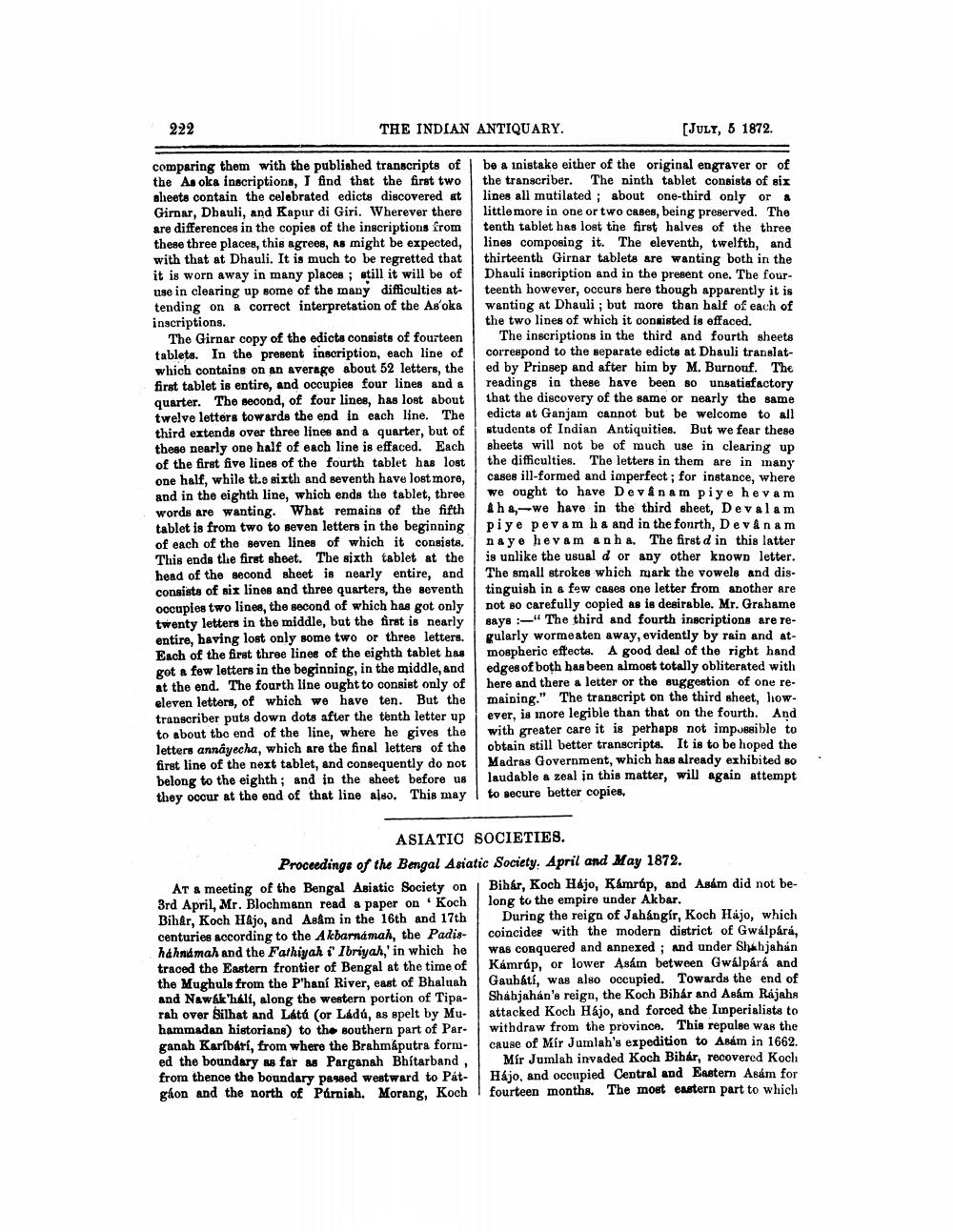________________
222
THE INDIAN ANTIQUARY.
[JULY, 5 1872
comparing them with the published transcripts of the Asoka inscriptions, I find that the first two sheets contain the celebrated edicts discovered at Girnar, Dhauli, and Kapur di Giri. Wherever there are differences in the copies of the inscriptions from these three places, this agrees, As might be expected, with that at Dhauli. It is much to be regretted that it is worn away in many places ; still it will be of use in clearing up some of the many difficulties attending on a correct interpretation of the As'oka inscriptions.
The Girnar copy of the edicts consists of fourteen tablets. In the present inscription, each line of which contains on an average about 52 letters, the first tablet is entire, and occupies four lines and a quarter. The second, of four lines, has lost about twelve letters towards the end in each line. The third extends over three lines and a quarter, but of these nearly one half of each line is effaced. Each of the first five lines of the fourth tablet has lost one half, while the sixth and seventh have lost more, and in the eighth line, which ends the tablet, three words are wanting. What remains of the fifth tablet is from two to seven letters in the beginning of each of the seven lines of which it consists, This ends the first sheet. The sixth tablet at the head of the second sheet is nearly entire, and consists of six lines and three quarters, the seventh occupies two lines, the second of which has got only twenty letters in the middle, but the first is nearly entire, having lost only some two or three letters. Each of the first three lines of the eighth tablet has got a few letters in the beginning, in the middle, and at the end. The fourth line ought to consist only of eleven letters, of which we have ten. But the transcriber puts down dots after the tenth letter up to about the end of the line, where he gives the letters annayecha, which are the final letters of the first line of the next tablet, and consequently do not belong to the eighth; and in the sheet before us they occur at the end of that line also. This may
be a inistake either of the original engraver or of the transcriber. The ninth tablet consists of six lines all mutilated ; about one-third only or a little more in one or two cases, being preserved. The tenth tablet has lost the first halves of the three lines composing it. The eleventh, twelfth, and thirteenth Girnar tablets are wanting both in the Dhauli inscription and in the present one. The fourteenth however, occurs bere though apparently it is wanting at Dhauli ; but more than half of each of the two lines of which it consisted is effaced.
The inscriptions in the third and fourth sheets correspond to the separate edicts at Dhauli translated by Prinsep and after him by M. Burnouf. The readings in these have been so unsatisfactory that the discovery of the same or nearly the same edicts at Ganjam cannot but be welcome to all students of Indian Antiquities. But we fear these sheets will not be of much use in clearing up the difficulties. The letters in them are in many cases ill-formed and imperfect; for instance, where we ought to have Devanam piye hevam Aha, we have in the third sheet, Devalam piye pevam ha and in the fonrth, Devanam naye hevam anha. The first d in this latter is unlike the usual d or any other known letter. The small strokes which mark the vowels and distinguish in a few cases one letter from another are not so carefully copied as is desirable. Mr. Grahame says :-" The third and fourth inscriptions are regularly wormeaten away, evidently by rain and atmospheric effects. A good deal of the right hand edges of both has been almost totally obliterated with here and there a letter or the suggestion of one remaining." The transcript on the third sheet, lowever, is inore legible than that on the fourth. And with greater care it is perhaps not impussible to obtain still better transcripts. It is to be hoped the Madras Government, which has already exhibited 80 laudable a zeal in this matter, will again attempt to secure better copies,
.
ASIATIC SOCIETIES. Proceedings of the Bengal Asiatic Society: April and May 1872. At a meeting of the Bengal Asiatic Society on Bihár, Koch Hájo, Kámráp, and Asam did not be3rd April, Mr. Blochmann read a paper on Koch long to the empire under Akbar. Bihar, Koch Hajo, and As&m in the 16th and 17th During the reign of Jahangir, Koch Hajo, which centuries according to the Akbarnamah, the Padis. coincidee with the modern district of Gwalpárá, hahnamah and the Fathiyah i' Ibriyah,' in which he was conquered and annexed ; and under Shahjahán traced the Eastern frontier of Bengal at the time of Kámráp, or lower Asám between Gwalpark and the Mughuls from the P'haní River, east of Bhaluah Gaubátí, was also occupied. Towards the end of and Nawakhali, along the western portion of Tipa- Shahjahán's reign, the Koch Bihár and Asam Rajahs rah over Bilhat and Latá (or Ladu, as spelt by Mu- attacked Kocb Hajo, and forced the linperialists to hammadan historians) to the southern part of Par. withdraw from the province. This repulse was the ganah Karíbari, from where the Brahmaputra form- cause of Mir Jumlah's expedition to Aram in 1662. ed the boundary as far as Parganah Bhítarband, Mir Jumlah invaded Koch Bihar, recovered Koch from thence the boundary passed westward to Pát- Hájo, and occupied Central and Eastern Asam for gion and the north of Párniah. Morang, Kochfourteen months. The most eastern part to which




